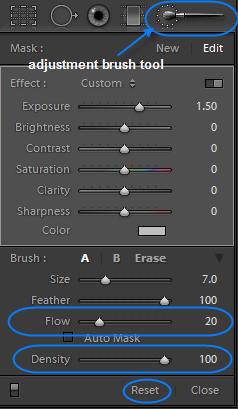Did you know that the adjustment brush allows you to slowly build up the amount of change you apply to an image, and also slowly back off on a change you made? The secret is in the Flow and Density sliders. Density controls how much of the specified adjustment can be applied in total, and Flow controls how many brush strokes it takes on the area to reach the full effect.
Let’s say that your goal is to brighten various parts of your image. You set the Exposure slider to +1.5 stops because you expect that this is the maximum brightening you would need to apply. Setting Density at 100% will allow you to apply the full 1.5 stop effect. If you set Flow at 20%, every brush stroke you make on an area will apply 20% of that 1.5 stops. Brush once on areas where you need just a little brightening; brush over areas twice or more –up to five times — where you need more brightening.
Now let’s say that there is an area that you brightened too much, and now you want to back off on the strength. To do so, reduce the density and paint over the area again — reducing it to 80% and painting again will give you just 80% of the effect. Painting with a density of 0% removes the effect entirely, and is therefore just like using the Eraser brush. (If it is an area that is difficult to precisely paint over again, you may find that it is easier to use the eraser brush first to remove the effect entirely and then start over again with applying the effect with flow reduced.)
There is no substitute for experimenting — everything you do in Lightroom can be undone! Play with the adjustment brush at different flow and density settings to understand what they do, and then hit the delete/backspace key on your keyboard to delete your current adjustment, or hit the Reset button just below the density slider to undo all your adjustment brush changes.

Adjustment Brush Flow and Density
